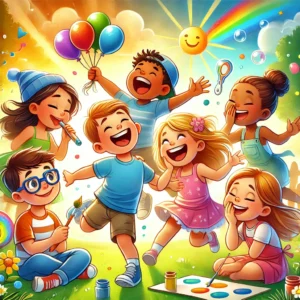Search Posts
Recent Posts
- Living Labyrinth, Inc. 501 c3 June 12, 2025
- Playful Energetic Emotions Exercises for Children February 5, 2025
- 🌿 Energetic Stillness for Children: A Gentle & Playful Approach to Calm & Balance 🌿 February 2, 2025
- 🌟 Energetic Nutrition for Children: A Fun & Playful Approach to Healthy Eating 🌟 February 1, 2025
- 🌟 Energetic Fitness for Children: A Philosophy & Ideology for Playful Movement 🌟 February 1, 2025
Categories
Subscribe!
Thanks for subscribing! Please check your email for further instructions.

Playful Energetic Emotions Exercises for Children

Playful Energetic Emotions Exercises for Children
Core Principle:
Every emotion is energy, and energy can be used for good!
The Energetic Emotions Ideology teaches children that their emotions are powerful forces that can be understood, shaped, and channeled into positive actions. It encourages emotional intelligence, resilience, and mindfulness in a fun and engaging way.
The Three Pillars of Energetic Emotions:
- Emotions are Energy:
- Just like electricity powers a lightbulb, emotions power our thoughts and actions.
- Every feeling—happiness, anger, sadness, excitement—is a form of energy that can be used in different ways.
- Energy Can Be Transformed:
- We can turn nervousness into courage, sadness into creativity, and anger into motivation.
- Emotions don’t have to control us; we can learn to guide them!
- Energy Affects Everything Around Us:
- Our emotions influence our actions, our friendships, and the world.
- Choosing how we use our emotional energy helps create a kinder and happier life.
Vanessa sharing Selfseeds emotions.
How to Apply This Philosophy:
🌟 Name It to Tame It
- Teach kids to identify their emotions: “I feel frustrated because I lost my toy.”
- Naming emotions helps them understand that feelings are temporary and manageable.
⚡ Energy Shifting Exercises
- From Anger to Strength: Instead of yelling, take deep breaths and punch a pillow or do jumping jacks.
- From Sadness to Creativity: Express feelings through drawing, writing, or building something.
- From Worry to Focus: Use mindfulness, like tracing a finger around a shape or counting deep breaths.
🔄 The Energy Exchange Rule
- If you receive negative energy (like someone being mean), choose to respond with positive energy (kindness, understanding, or humor).
- Like a superhero redirecting lightning, children can learn to turn negativity into something powerful and good.
💖 Spread the Good Energy
- Smiling at someone can lift their energy.
- Helping a friend creates a chain reaction of kindness.
- Gratitude turns small moments into happiness.
A Fun Metaphor for Kids:
Your Emotions Are Like Superpowers!
- Anger = Fire 🔥 (Use it to stand up for fairness, not to hurt.)
- Happiness = Sunshine ☀️ (It warms others when shared.)
- Sadness = Rain 🌧️ (It helps things grow and brings new ideas.)
- Excitement = Lightning ⚡ (Fast, powerful, and needs to be focused.)
By learning how to use their Energetic Emotions, children can grow into emotionally intelligent, kind, and confident individuals who shape their world for the better!
Energetic Emotions Activity Guide for Kids
Helping Kids Understand, Transform, and Channel Their Emotions Positively!
🌟 Introduction:
This activity guide is designed to help children understand that emotions are a type of energy that can be transformed and used in positive ways. Through fun exercises, they will learn how to recognize, shift, and channel their emotions effectively.
🔵 Section 1: Understanding Emotions as Energy
Activity 1: Emotion Energy Meter
📌 Objective: Teach kids that emotions have different levels of energy and can change.
📝 Materials: A blank paper and colored markers.
🔹 Instructions:
- Draw a thermometer or a battery on the paper.
- Label it with different emotions from low energy (sad, tired) to high energy (excited, angry).
- Ask kids to mark where they feel right now.
- Discuss how emotions can move up or down, just like energy levels!
Activity 2: Emotion Detective
📌 Objective: Help children recognize emotions in themselves and others.
📝 Materials: Emotion cards (drawn or printed).
🔹 Instructions:
- Show children different pictures of facial expressions or act them out.
- Have them guess what emotion is being shown.
- Discuss how different emotions feel in their bodies (e.g., “What does anger feel like?”).
- Let them share a time they felt each emotion.
🟠 Section 2: Transforming Emotions
Activity 3: Energy Shift Dance
📌 Objective: Teach kids how to shift emotional energy through movement.
📝 Materials: Music.
🔹 Instructions:
- Start with slow, calming music and ask kids to move like they feel sad.
- Change to fast, upbeat music and encourage them to dance excitedly.
- Introduce a rhythm where they jump out frustration, shake off nervousness, or stretch into calmness.
- Discuss how movement helps change emotions.
Activity 4: Magic Emotion Paintbrush
📌 Objective: Use art to express and shift emotions.
📝 Materials: Paint, crayons, or colored pencils.
🔹 Instructions:
- Ask kids to choose a color that matches how they feel.
- Have them draw or paint a picture that represents that emotion.
- Now, ask them to pick a “magic color” that helps them feel better and add it to their artwork.
- Discuss how colors and creativity can help transform feelings.
🟢 Section 3: Channeling Emotions Positively
Activity 5: Power Pose Challenge
📌 Objective: Teach confidence and control over emotions using body language.
📝 Materials: None.
🔹 Instructions:
- Ask kids to stand like a superhero (feet apart, hands on hips, head up).
- Have them say an affirmation (e.g., “I am strong and kind!”).
- Encourage them to hold this pose for 10 seconds and notice how they feel.
- Discuss how body language can shift emotions.
Activity 6: Energy Exchange Game
📌 Objective: Help children practice turning negative energy into positive energy.
📝 Materials: A ball or soft toy.
🔹 Instructions:
- Sit in a circle. One child starts with a “negative” emotion (e.g., “I feel frustrated because my toy broke”).
- The next child suggests a positive action to turn the energy around (e.g., “Maybe you can fix it or play with something else!”).
- Pass the ball to the next person, and continue transforming emotions into positive actions.
💖 Section 4: Spreading Positive Energy
Activity 7: Kindness Chain Reaction
📌 Objective: Show how kindness spreads positive energy.
📝 Materials: Strips of paper and tape.
🔹 Instructions:
- Each child writes or draws an act of kindness they did today.
- Connect the strips to form a kindness chain.
- Watch how kindness grows when everyone contributes!
Activity 8: Gratitude Sparks
📌 Objective: Teach kids how gratitude shifts energy.
📝 Materials: A small jar and paper.
🔹 Instructions:
- Every day, kids write down one thing they are grateful for.
- Put it in the jar and read them at the end of the week.
- Discuss how gratitude makes us feel happier.
🎉 Conclusion: Superpower Celebration!
📌 Final Activity: Create an Emotion Superpower Badge for each child, representing how they have learned to use their emotions wisely.
📝 Materials: Paper, stickers, markers.
🔹 Instructions:
- Let kids design their own badge.
- Ask them to write their new superpower (e.g., “I can turn sadness into creativity!”).
- Celebrate their journey in becoming Emotion Energy Masters!
✨ Final Thought:
This guide helps kids recognize, transform, and use their emotions in positive ways, making them feel more confident and in control of their energy.

🌟 Extra Storytelling Activities for Energetic Emotions!
These storytelling activities help kids explore emotions through imagination, creativity, and role-playing.
📖 Storytelling Activity 1: The Emotion Energy Adventure
📌 Objective: Help children visualize emotions as energy that can be transformed and used wisely.
📝 Instructions:
- Set the Scene: Tell kids they are explorers in the Land of Emotions, where different emotions live as magical creatures.
- Introduce Characters:
- Joy the Lightning Fairy ⚡ (spreads excitement but needs focus)
- Anger the Fire Dragon 🔥 (strong but must learn control)
- Sadness the Rain Spirit 🌧️ (gentle and helps things grow)
- Fear the Shadow Cat 🐱👤 (sneaky but can turn into courage)
- The Challenge:
- The Emotion Crystal has been shattered, and the world is out of balance! Each child must help one emotion find its positive purpose.
- Kids come up with creative solutions (e.g., teaching the Fire Dragon to use its flames for warmth instead of destruction).
- The Ending:
- Once all emotions are balanced, the Emotion Crystal is restored!
🔹 Variation: Let kids draw their own emotion creatures and tell their own adventure story.
🎭 Storytelling Activity 2: “What Happens Next?”
📌 Objective: Encourage problem-solving and emotional awareness through storytelling.
📝 Instructions:
- Start a Short Story: Give kids a short scenario where a character faces an emotional challenge.
- Example: Maya was so excited for the talent show, but right before she went on stage, she felt butterflies in her stomach. Her hands were sweaty, and she wasn’t sure if she could do it…
- Ask the Kids: What happens next?
- Let Them Decide: They can act it out, draw it, or tell the next part of the story using emotion-energy principles (e.g., Maya breathes deeply and turns her nervousness into confidence).
- Wrap Up: Discuss how the character’s choices changed the story.
🔹 Variation: Use different emotions (anger, sadness, frustration) and let kids explore different positive ways to handle them.
🌈 Storytelling Activity 3: “The Emotion Potion”
📌 Objective: Teach kids that emotions can be mixed and transformed like magic.
📝 Instructions:
- The Setup:
- Kids are Emotion Alchemists in a magical laboratory.
- Their task is to create a potion to change how someone feels.
- The Ingredients:
- Ask: If you wanted to make a potion for bravery, what ingredients would you use?
- Examples: Sunshine rays (happiness), tiger whiskers (courage), and deep breaths (calmness).
- Mixing the Potion:
- Kids describe or draw how their potion works.
- They role-play giving the potion to someone who needs it (e.g., a shy friend who needs confidence).
- Wrap Up:
- Discuss how emotions mix, change, and influence each other.
🔹 Variation: Have kids “test” their potions by acting out how they would feel after drinking them!
🚀 Storytelling Activity 4: “Emotion Time Travelers”
📌 Objective: Show kids how emotions change over time and help them develop patience and perspective.
📝 Instructions:
- The Setup:
- Kids are Time Travelers who can visit their past and future selves.
- Each child picks an emotion they’ve felt recently (e.g., frustration about a lost toy).
- The Past:
- Travel five minutes back and describe how they felt.
- Travel one hour back—is the feeling the same or different?
- Travel one day back—do they still feel as strongly?
- The Future:
- Travel one day ahead—how do they think they’ll feel?
- Travel one year ahead—will they still remember it?
- Wrap Up:
- Discuss how emotions feel big in the moment but often change with time.
- Encourage kids to think, “Will this feeling still be as strong tomorrow?” before reacting.
🔹 Variation: Let them “meet” their future self and get advice on handling emotions!
💭 Storytelling Activity 5: The Superhero of Feelings
📌 Objective: Empower kids to view their emotions as strengths.
📝 Instructions:
- The Setup:
- Kids create a superhero version of themselves based on an emotion they want to master.
- Example: “Captain Calm” can breathe deeply and spread peace to anyone feeling angry!
- The Mission:
- A villain (like The Worry Wizard or The Frustration Fiend) is causing trouble.
- The superhero must use their emotion-energy powers to save the day.
- The Story:
- Kids describe or act out how they transform negative emotions into positive actions.
- Example: Captain Calm teaches deep breathing to the city, and The Worry Wizard loses his power!
- Wrap Up:
- Discuss how everyone has an “emotional superpower” they can use daily.
🔹 Variation: Kids can make superhero capes and badges with their superpower names!
✨ Conclusion: The Power of Storytelling for Emotions
These activities help kids engage with emotions in a fun, creative way while learning practical skills to manage their feelings.
🌟 Additional Interactive Elements for Energetic Emotions Storytelling Activities
These interactive elements will make the storytelling activities even more engaging for children by incorporating movement, props, role-playing, and hands-on participation!
🎭 1. Emotion Mask-Making (Perfect for “The Superhero of Feelings”)
📌 Objective: Create fun, expressive masks to help children act out different emotions.
📝 Materials: Paper plates, markers, glue, craft sticks, stickers, and other decorations.
🔹 Instructions:
- Give each child a paper plate or mask template to design an emotion mask.
- Let them create masks representing one emotion (e.g., an “Excitement Mask” with bright colors, an “Anger Mask” with flames).
- Attach a craft stick or string so they can wear their masks.
- Storytelling Game: Have kids use their masks while acting out a scene where their character learns to manage the emotion.
🔹 Variation: Create two-sided masks (one side showing the emotion before, the other side after a positive transformation).
🎲 2. Emotion Dice Game (Great for “The Emotion Potion” and “What Happens Next?”)
📌 Objective: Add a random storytelling element where kids roll dice to determine the emotions in a story.
📝 Materials: A six-sided die and an Emotion Chart.
🔹 Instructions:
- Create a simple Emotion Chart (Example):
- 1️⃣ = Joy
- 2️⃣ = Sadness
- 3️⃣ = Anger
- 4️⃣ = Fear
- 5️⃣ = Surprise
- 6️⃣ = Love
- Have a child roll the die to decide how their character feels in the story.
- Continue rolling to add challenges (e.g., “What happens next?” or “How does the emotion change?”).
🔹 Variation: Make a second die with different situations (e.g., “Loses a toy,” “Gets a big surprise”) and combine them for unique storytelling!
🎤 3. “Emotion Radio Show” (Fun for “Emotion Time Travelers”)
📌 Objective: Kids become radio hosts sharing their emotional journeys in a fun way!
📝 Materials: A toy microphone (or rolled-up paper as a mic).
🔹 Instructions:
- Set up an “Emotion Radio Station” where kids take turns being the host.
- The host interviews another child about an imaginary emotional experience (e.g., “Tell us about a time you felt really nervous, but you turned it into bravery!”).
- Encourage dramatic storytelling as kids describe what happened and how they managed the emotion.
- The host wraps up with a “Lesson of the Day” based on the story.
🔹 Variation: Record their radio show and play it back to discuss!
🎨 4. Emotion Energy Maps (Ideal for “Emotion Energy Adventure”)
📌 Objective: Create a visual journey of emotions.
📝 Materials: Large sheets of paper, crayons, stickers, and markers.
🔹 Instructions:
- Each child draws a “map” of their emotions like an adventure world.
- Key locations could include:
- Happiness Hill 🌄
- The Angry Volcano 🌋
- Sadness Swamp 🌊
- The Courage Castle 🏰
- They draw paths and obstacles between them (e.g., “To leave Sadness Swamp, you must cross the Kindness Bridge”).
- They then tell a story about their adventure through the emotion landscape.
🔹 Variation: Kids swap maps and navigate a friend’s “Emotion World”!
🕵️♂️ 5. “Guess That Emotion!” Charades (Fun for “Emotion Detective”)
📌 Objective: Improve nonverbal emotional recognition and empathy.
📝 Materials: Emotion cards (can be drawn or written).
🔹 Instructions:
- Write or draw different emotions on index cards.
- A child picks a card and acts out the emotion without speaking.
- The rest of the group guesses the emotion.
- After guessing correctly, discuss:
- “How can you tell when someone feels this way?”
- “What would help someone who feels this way?”
🔹 Variation: Have kids act out a transformation, such as turning “fear” into “bravery”!
🎟️ 6. Emotion Theater Tickets (Engaging for “The Superhero of Feelings”)
📌 Objective: Make storytelling more immersive with audience participation.
📝 Materials: Paper for “Emotion Theater Tickets.”
🔹 Instructions:
- Before a storytelling session, give each child a ticket with an emotion (e.g., “Today, you are an audience member watching a Courage Story!”).
- Kids take turns acting out or telling stories as if they were performing on stage.
- After each performance, the audience claps, cheers, or asks questions like a real show!
🔹 Variation: Create Golden Tickets that let an audience member join the performance as a supporting character.
💡 Conclusion: Making Storytelling More Dynamic!
Adding these interactive elements keeps children engaged and reinforces the lesson that emotions are powerful energies they can transform and control.





